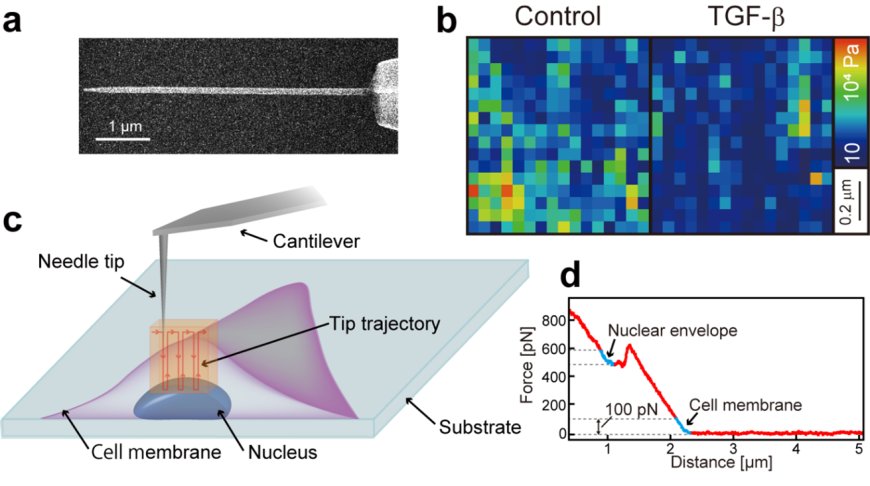Nanotechnology research uncovers cancer cells flexibility
Nanotechnology research uncovers cancer cells flexibility

(Kanazawa, Japan) Researchers at Kanazawa University's Nano Life Science Institute (WPI-NanoLSI) developed Nanoendoscopy-AFM (NE-AFM), a new method to precisely measure and map the nuclear elasticity (stiffness or softness) of intact living cells.
Key takeaways include:
Technological Advancement: NE-AFM overcomes limitations of traditional Atomic Force Microscopy (AFM) by using a nanoneedle probe (about 160 nm in diameter) inserted directly into the cell. This method avoids interference from the cell membrane and cytoskeleton, providing an accurate, nanoscale map of the nucleus's mechanical properties (Ichikawa et al., 2024).
Cancer Findings in Lung Cancer Cells (PC9):
Nuclear Stiffening: Human lung cancer cells (PC9) showed significantly increased nuclear elasticity (stiffening) under serum-free conditions. This correlated with increased chromatin compaction, specifically marked by higher levels of trimethylation of histone H4 at lysine 20 (H4K20me3).
Nuclear Softening: Treatment with Transforming Growth Factor beta (TGF-$\beta$), which induces epithelial–mesenchymal transition (EMT) (a process linked to metastasis), caused nuclear softening and a reduction in H4K20me3 levels.
Mechanism of Elasticity Change: The study suggests that changes in nuclear elasticity are primarily driven by chromatin compaction states (changes in how DNA and proteins are packed), not by alterations in nuclear lamins (Ichikawa et al., 2024).
Relevance to Metastasis: Brain-metastatic derivatives of PC9 cells (PC9-BrM) showed similar elasticity trends, implying that chromatin regulation of nuclear mechanics plays a role in their invasive behavior.
Biomarker Potential: The findings indicate that nuclear elasticity can serve as a measurable physical biomarker for cancer progression, which could lead to new approaches for diagnosis, prognosis, and evaluating treatment efficacy (Ichikawa et al., 2024).
References
Ichikawa, T., Kono, Y., Kudo, M., Shimi, T., Miyashita, N., Maesaka, T., Ishibashi, K., Yoshida, T., Sivashanmugan, K., Hanayama, R., Hirata, E., Miyata, K., Kimura, H., & Fukuma, T. (2024). Probing nanomechanics by direct indentation using Nanoendoscopy-AFM reveals the nuclear elasticity transition in cancer cells. ACS Applied Nano Materials. DOI: 10.1021/acsanm.5c03044
Source Kanazawa University
What's Your Reaction?
 Like
0
Like
0
 Dislike
0
Dislike
0
 Love
0
Love
0
 Funny
0
Funny
0
 Angry
0
Angry
0
 Sad
0
Sad
0
 Wow
0
Wow
0








